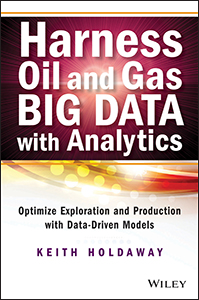Oil companies are being forced to explore in geologically complex and remote areas to exploit more unconventional hydrocarbon deposits. New engineering technology has pushed the envelope of previous upstream experience. No guidebook existed on how computing methodologies can contribute to E&P performance at reduced risk. Until now.
 A new book for oil and gas professionals reveals the keys to data management, quantification of uncertainty, and risk assessment across the exploration and production (E&P) enterprise. Written for IT professionals, geophysicists, geologists and petroleum engineers, Harness Oil and Gas Big Data with Analytics offers sage advice from author and industry veteran, Keith Holdaway.
A new book for oil and gas professionals reveals the keys to data management, quantification of uncertainty, and risk assessment across the exploration and production (E&P) enterprise. Written for IT professionals, geophysicists, geologists and petroleum engineers, Harness Oil and Gas Big Data with Analytics offers sage advice from author and industry veteran, Keith Holdaway.
Keith is a friend and colleague, so I quickly took him up on an early copy of the book. In my opinion, the book (all 330 pages) is a technical primer for an executive audience. No advanced degrees required, but this book will be flagged and dog-eared by savvy petroleum professionals. There are tables that match the best algorithm for different outcomes desired – correlation vs relevance, for example. And case studies on drilling optimization, reservoir modeling, and decline curve analysis, to name a few.
"This is a time of great change in the oil and gas industry, and even before embracing real time systems, we were struggling to extract meaningful insights from a large accumulation of data that was right under our noses. Reading this book you will begin to see your data as the insight it was intended to be, and not the burden it has become.” - Dennis Seemann, Supervisor, Reservoir Management Analytical Division, Saudi Aramco
The book highlights one of the most important changes taking place in the industry today -- the shift from deterministic model building and interpretation to stochastic and soft computing methods. This shift takes place as companies strive to use more data-driven approaches to:
- Increase reliability in reserves information.
- Reduce subsurface uncertainty.
- Manage portfolios of disparate exploration and production data.
- Preclude production loss and anticipate reservoir damage.
- Create seamless communication paths among exploration and production silos.
“To stay competitive, E&P companies must apply robust forecasting and identify more effective field re-engineering strategies for mature assets," Keith explained. "Technology is making dramatic strides into automated and integrated production optimization. In 20 years, every reservoir considered uncommercial today will be commercially viable. I wrote Harness Oil and Gas Big Data with Analytics to help companies explore and model analytics approaches to geophysical, geologic and reservoir engineering data so they can meet tomorrow’s challenges head on.”
I’m confident that Keith has enabled petroleum professionals in the workforce today, as well as those in generations to come. With these insights, readers will boost their personal and professional analytical competencies. Well done, Keith!
More about the book’s author: Holdaway spent 15 years as a geophysicist. His work with the Ministry of Petroleum in Saudi Arabia, British Petroleum in the United Arab Emirates, and Shell Oil in Oman adds up to a wealth of experience processing and interpreting seismic and reservoir data. An expert on mapping SAS technology to geology and geophysics, Holdaway thrives on sharing his expertise with customers. He is active in the Society of Exploration Geophysicists, the European Association of Geoscientists and Engineers, and the Society of Petroleum Engineers. He is also a Fellow of the Geological Society of London.
